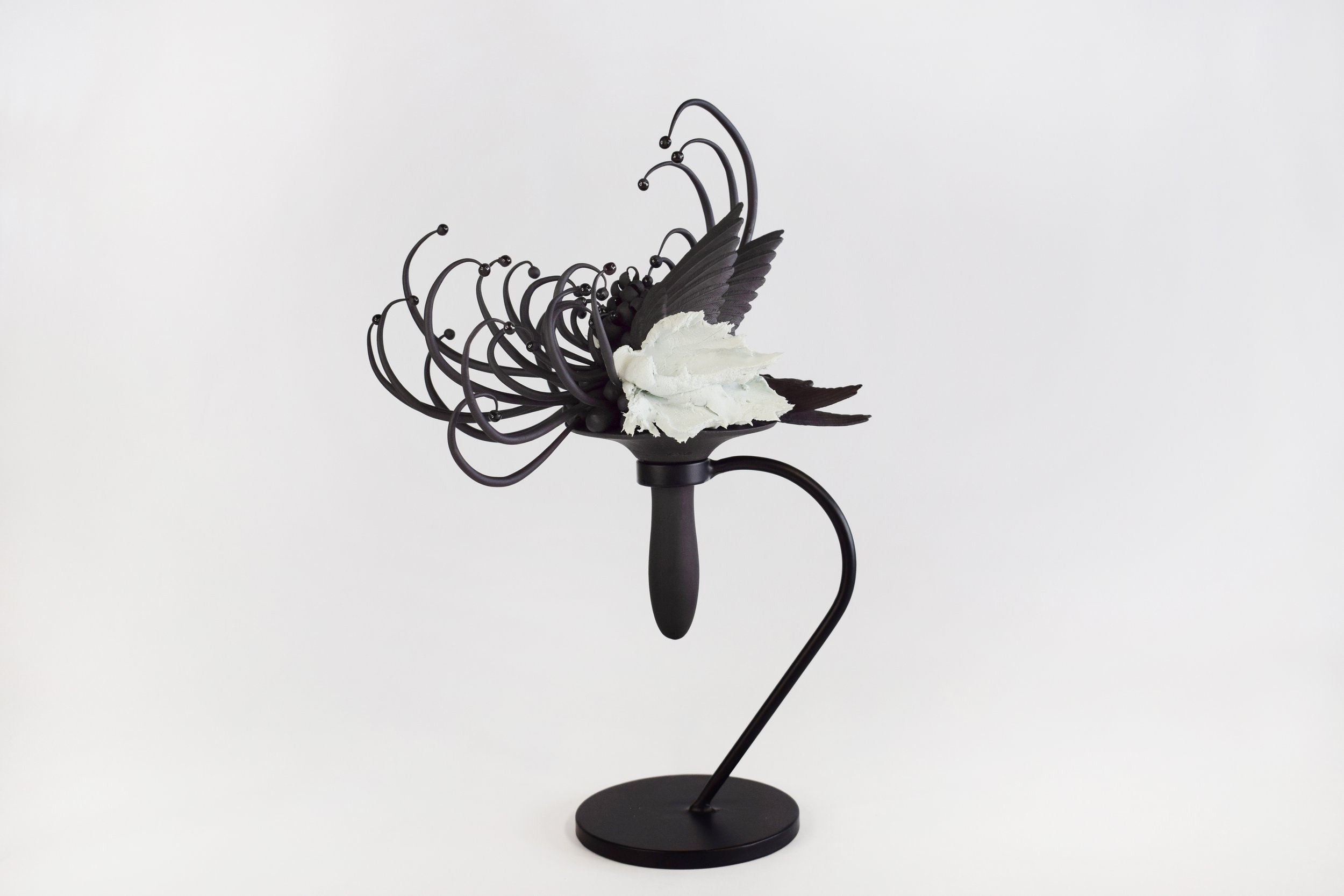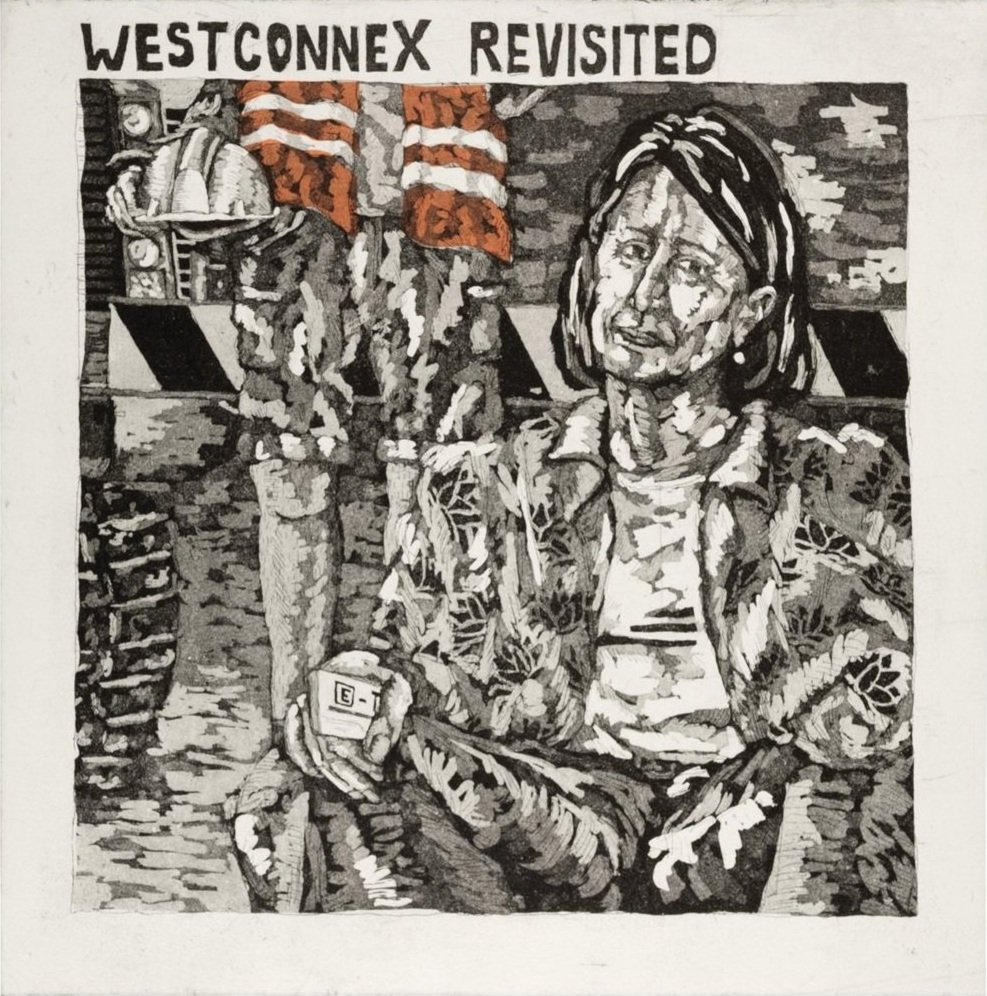Education Resources for Teachers and Students
Download the full education kit HERE
Shoufay Derz, Loving the alien, Bo / open 2023, from the series Ritual of eels, pigment print on cotton paper, 71.6 x 91.1 cm
HOME AND AWAY: Eight Asian Australian Artists
‘Home,’ it seems, is both nowhere and everywhere
The eight artists in Home and Away invite us to consider notions of ‘home’ and familial or ancestral connection in our increasingly uncertain world of porous borders, geopolitical tensions and climate change anxiety. Their constructions of selfhood and attachments to ‘home’ are built upon ancestral ties to Asia juxtaposed with fluid Asian/Australian identities. This is a process of becoming, a transcultural identity that the scholar Stuart Hall described as a form of ‘always postponed arrival’. Some were born elsewhere and migrated to Australia, others are Australian-born with parents who came as migrants. Some live and work in Australia and some have moved to a third country, navigating new diasporic uncertainties. They embrace their mobility, as they interrogate their own real and imagined journeys.
We all carry within us cartographies of identity – maps of everywhere we have lived, loved and lost. Over our lives these become a palimpsest of overlapping, overwritten fragments of time and place. In multicultural Australia such personal geographies are complicated, encompassing migration, the crossing of oceans and borders, the learning of new languages and unfamiliar cultural norms, and the reinvention of self. Unsurprisingly, cultural histories and references to Asian material culture are recurring themes in the work of these artists. A subtext of loss underlies many works, but this is juxtaposed with a strong desire for connection with cultural heritage, with language, and with the natural world. And in the work of each artist, the physical, material properties of their chosen media and techniques are pregnant with meaning. ‘Home,’ it seems, is both nowhere and everywhere. It is always with us, and within us – whether we are here, or there, or somewhere else.
Scroll down for suggestions and activities for teachers and students.
For Teachers
Home and Away invites the integration of artists of Asian Australian upbringing into existing curricula and case study investigations. The exhibition provides an insight into personal experiences of displacement and discusses themes and perspectives on the notions of home, selfhood, belonging and identity. The eight artists span across a diversity of Asian nationalities, allowing students to immerse themselves in cultures and beliefs within the region, as well as explore the contrasting Australian societies the artists have established as a ‘home away from home’. The exhibition demonstrates the artists’ construction of selfhood through their connection to familial rituals, beliefs and traditions, while they share their upbringing and their idea of belonging in an Australian context.
Home and Away speaks to significant cultural and social issues existing with students’ communities and nation. Australia is a multicultural country, made up of diverse races, languages, beliefs and customs. The themes and experiences discussed by the exhibiting artists capture contemporary Australia and its population. The artists live and work transculturally and communicate ideas of this nature. Depending on the geographical location, many students will be able to relate on a personal or community-based level. All students can use this exhibition to understand the complex human fabric that makes up their country. This exhibition and its educational resources provide an understanding that education on diversity, through any expression such as arts, is of value and high importance to the future of social progression and national identity.
Case Study
Consider examining and teaching this exhibition as an extension study following an Art & Identity, Art & Borders or Art & Women Artists case study.
Through these lenses students investigate the exhibition to examine how life experience, heritage and family can impact an artist’s practice and understanding of their world. Therefore, teachers and students are encouraged to focus on the Subjective Frame and Conceptual Framework throughout the case exploration of this exhibition.
A key aspect of Home and Away is the idea that mediums and materiality can be used to communicate memories. As such, there is a diverse use of materials and processes used by the artists, which derives from their desire to connect with their family’s lineage and culture by accessing memories and childhood experiences. As such, teachers and students are encouraged to question artists’ choices and intentions by examining their material and conceptual practices and the relationship between material and message.
Suggested 16albermarle Project Space exhibitions and case studies:
Our Grandfather Road: The (gendered) body and place in contemporary southeast Asian art.
https://www.16albermarle.com/ogr-educationGhosts from the past: Ipeh Nur and Enka Komariah
https://16albermarle.com/ex13-education
Home and Away features strong female artist practices, therefore teachers and students might also look comparatively at works by diaspora artists such as:
Iranian female artists:
Exiled Shirin Neshat
https://nmwa.org/art/artists/shirin-neshat/Roya Ebtehaj
https://royaebtehaj.com/aboutKiana Honarmand
https://www.kianahonarmand.com/about
Asian female artists:
Taiwanese-American Stephanie H. Shih
https://stephaniehshih.com/Philippines-American Maia Cruz Palilio
https://www.maiacruzpalileo.com/aboutLaotian-Australian Mechelle Bounraseuth
https://www.chalkhorse.com.au/artists/mechelle-bounpraseuth
CURRICULUM AND SYLLABUS LINKS
Teachers are encouraged to adapt this education resource for their curriculum, in and outside NSW. This education kit makes the following connections to:
Visual Arts NSW Stage 6 Syllabus:
Art Criticism/Art History Focus area:
Practice: Artists and their experience with migration and cultural diversity / Artists, material practice and meanings / Curators and their role in social discussions
Conceptual Framework: the ways in which the personal and wider world is communicated through art by the artist
The Frames: Cultural history/Structural and material impact/Subjective and the use of symbols
Identity and home as a Subject Matter
Art Criticism and Art History Outcomes:
Stage 5 Course: 5.7, 5.8, 5.9, 5.10
Stage 6 Year 11: P7, P8, P9
Stage 6 HSC Year 12: H7, H8, H9
International Baccalaureate Diploma Syllabus:
Theoretical Practice
Visual Arts in Context: Students examine artists working in different cultural contexts and seek to understand the limitations and possibilities to discuss historical events through artmaking.
Visual Arts in Methods: Students look at different techniques for making art. Students investigate and compare how and why different techniques have evolved, and the processes involved.
Curatorial Practice
Visual Arts in Context: Students develop an informed response to work and exhibitions they have seen and experienced.
Visual Arts in Methods: Students consider the nature of “exhibition” and think about the process of selection and the potential impact of work on different audiences.
FAMILIARIES YOURSELF WITH THESE TERMS
Diaspora: the dispersion or spread of a people from their original homeland. Please visit the Tate Museum Diaspora Art Term website to unpack this term in relation to contemporary and historical art contexts.
Transcultural: relating to or involving more than one culture; cross-culture.
EXHIBITIONS QUESTIONS
The questions provided in this resource may be used for written responses, examination preparation, or for open-ended discussions in the gallery or the classroom.
Pre-visit Questions for Years 9 – 12
What is your idea of home? How has that been informed throughout your life?
When do you feel like you belong? List the words, experiences, places, or actions that make you feel this way.
How can family impact the way we see ourselves and the world?
Extended Response HSC Questions
Frames:
Select ONE of the artists shown in Home and Away and ONE artist you have studied. With reference to the specific works, answer this extended response question:
Analyse how emotion is used in artworks to provoke and generate discussion about ideas and issues.
Practice:
Select TWO of the artists shown in Home and Away. With reference to the specific works, answer this extended response question:
Explore how artist use their material practice to communicate ideas about their identity and self.
Conceptual Framework:
Select ONE of the artists shown in Home and Away and ONE artist you have studied. With reference to the specific works, answer this extended response question:
Analyse how TWO artists reflect and/or challenge aspects of their contemporary worlds.
Ida Lawrence, Batas Suci 2022, acrylic in polycotton, 155 x 120 cm
FOCUS ACTIVITIES
Here you will find Home and Away artist questions for classroom discussions. Teachers are encouraged to download the Home and Away catalogue and present the curatorial essay to their students. In this reading students can hear further information on the notion of diaspora and gain explicit information on how each artist addresses their ideas on ‘home’. These activities also require access to artist interviews found on the 16albermarle Home and Away exhibition page.
About contemporary art
in southeast Asia
Eluding simple definitions or falsely universalising connections between distinct histories and cultures, the art of southeast Asia is vibrant, dynamic and complex, bearing traces of “the rise and fall of kingdoms and empires, and … the historical traces of colonisation and the often-traumatic birth of nations.”1 Artists from Indonesia, Cambodia, Thailand, Myanmar, Laos, the Philippines, Vietnam, Singapore and Malaysia explore local and global themes including personal and national identity and community, cultural knowledge, power, faith and the increasingly urgent impact of humans on fragile ecosystems.
Find out more
https://theartling.com/en/artzine/artist-defined-contemporary-southeast-asian-art
https://www.sothebys.com/en/articles/five-of-the-most-influential-women-artists-from-southeast-asia
https://artradarjournal.com/7-influential-women-artists-from-asia-pacific/
Joan Kee (2011) Introduction Contemporary Southeast Asian Art, Third Text, 25:4, 371-381, DOI: 10.1080/09528822.2011.587681 at https://www.tandfonline.com/doi/pdf/10.1080/09528822.2011.587681
1 “No Country: Contemporary Art for South and Southeast Asia”, Solomon R. Guggenheim Museum and Foundation
Ida Lawrence, Batas suci 2022, acrylic on polycotton, 155 x 120 cm
Other Education Resources:


















